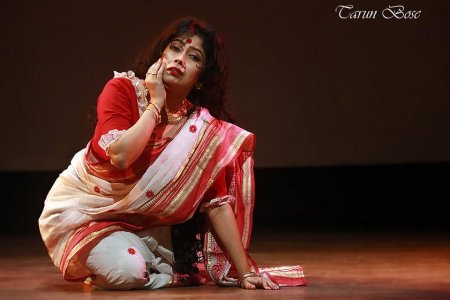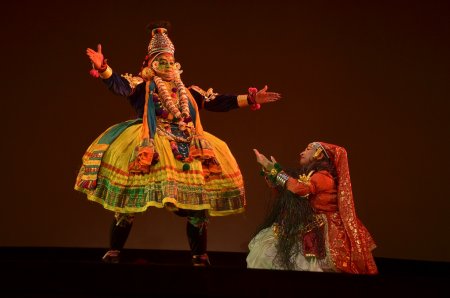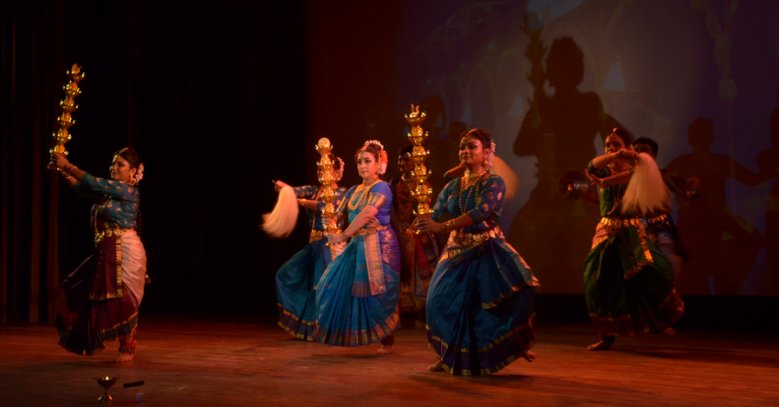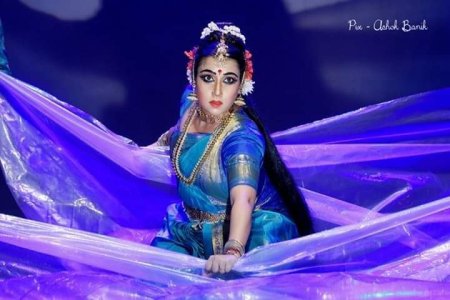
|   |

|   |
International Performing Arts Festival in Kolkata - Nita Vidyarthi e-mail: nitavidyarthi@gmail.com Photos courtesy: Jhinook Mukherjee Sinha March 3, 2020 International Performing Arts Festival (IPFA) is an initiative by social entrepreneur Shyam Pandey which aims at uniting societies and cultures with fusion of arts globally. The organisation encourages art forms and holistic traditions through performing arts across societies. IPAF supports Vayu Yoga, Classical and Folk dances, differently abled and upcoming artists to ensure that the tradition remains vibrant and is passed down to the youth. It provides a global platform to artists, organises festivals in every state capital and culturally rich cities of India. This is the 3rd year in Kolkata organised at the Satyajit Ray Auditorium, ICCR. A line-up of four performances by award winning artists was staged. The evening opened with an audio presentation in Bengali, as a tribute to Mahatma Gandhi by Shrutibritto, directed by Suvadeep Chakravarty and his group. The production, based on the life of the Mahatma was strung together with narrations of important events of his life, readings, recitations, songs and comments by luminaries of the freedom struggle, highlighting the relation between Tagore and Mahatma. It was interspersed with three soul-stirring Rabindrasangeets by the renowned singer Prabudhha Raha, including the familiar "Ekla chalo re" - the favourite song of the Mahatma - a ghazal by Parag Roy spiced with a classical alaap and vilambit bandish by Pallabi Ghatak. However, the production did not rise above mediocrity.  Rumeli (Pic-Tarun Bose)  Duryodhana Vadham The dance presentations began with a solo performance by the popular 'creative' dancer and choreographer Rumeli, based on Rabindranath Tagore's sublime and emotionally charged philosophical song "Jokhun padbena more payer chinho ei batey" (when my footprints will no longer be visible on this path). It is a composition seldom set to a dance number for its difficult representation of the serious, sombre and intensely introspective content, signifying profoundly the existence in this world, death and rebirth. Rumeli's interpretation and presentation distinctly disillusioned the content by her aggressive dancing and over-excited dramatic theatrical treatment and deportment. The traditional Kathakali performance by the seasoned dancer Diptanshu Paul, disciple of Guru Kalamandalam Venkitt, was a nuanced display of power and eloquence of the dance idiom. Artistic director of the well-known group Diptangshu Gargi Performing Troupe, Diptangshu designed his recital in three parts based on the padam "Paripahimam hare, Padmalaye pate" in ragam Navarasam from the act of Duryodhana Vadham from the Mahabharata. It was splendidly represented by Diptangshu as Krishna and Srija Karmakar as Draupadi both in complete traditional costume with sharpness and precision of movements. Diptanshu in his solo had a grand presence and demonstrated neatness and finesse of a fine performer where every gesture brought alive the episodic order with Úlan. The crowning glory of the festival was the riveting dance presentation 'Namami Gange' by Bharatanatyam dancer Jhinook Mukherjee Sinha and her group. Recipient of a number of awards, Jhinook has performed extensively at home and abroad and acquired a keen sense of aesthetic experience that inspires her choreography and colours her art. Symbolising Ganga metaphorically as a woman from a chirpy young girl to a youthful and bubbly maiden in her prime, a dutiful wife, a selfless mother, and maturing as her journey advances with age and a dauntless rebel, protesting and standing against all odds, Jhinook picturises the Ganga resonating with all the emotions of a woman who finally protests her exploitation and pollution and crusades to remedy its cause. Despite being sacred, Ganga's life is a turbulent story.  Namami Gange  Jhinook Mukherjee Sinha (Pic: Ashok Banik) Marriage of Ganga, Ganga puja, a soulful song "Purab se jab suraj nikla" by Chitra and Jhinook's energetic solo with a delicate jump, quivering hands while playing the damaru with "Om Namah Shivaya" against the backdrop of Mahadeva's picture appealed and provided an elegant setting. The final Ganga Arati with large multi-tiered lamps and mounted Yak tails by the dancers (both boys and girls) set to thunderous "Jai Gange Hara Hara Gange" proved that the production was perhaps strangely familiar, but an original piece, with commonplace theme, constructed entirely from recognisable classical Bharatanatyam sequences each exactly set to musical rhythm, but choreographed with variations in steps and poses. And the consummate dancer Jhinook Mukherjee Sinha used the standard classical form and shaped her 'Namami Gange' into kaleidoscopic crystalline patterns, layered with musical time and stage space using her training, talent and imagination. Jhinook's production and dancing created a dazzling imagery uplifting dance. Dr. Nita Vidyarthi is a veteran critic of performing arts and writes on dance, music and theatre in leading publications. |